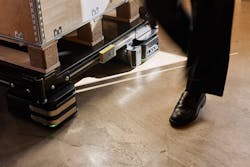ADAR vs. LiDAR: The Next Evolution in Autonomous Mobile Robot Sensing Technology
- Sonair introduces ADAR (acoustic detection and ranging), a 3D ultrasonic sensing technology designed to enhance safety and perception in autonomous mobile robots.
- Unlike 2D LiDAR, ADAR offers a full 180x180-degree field of view and detects objects and people in 3D, improving robot awareness in shared human environments.
- With more than 20 global companies validating the technology and safety certification expected by end of 2025, ADAR is poised to become a major player in AMR sensing.
When you read or hear about the sensor technology that enable autonomous mobile robots (AMRs) to navigate throughout a facility with crashing into machines or people, that sensor technology tends to be LiDAR (light detection and ranging). This sensing method determines distance between the detector and object by targeting an object or a surface with a laser and measuring the time for the reflected light to return to the receiver. LiDAR can be configured to operate in a fixed direction, but it can also scan in multiple directions when combined with 3D and laser scanning — which is typically the case in AMR applications.
In the near future, when you ask about the sensor tech enabling a particular robot’s autonomous abilities, you’re more likely to find that LiDAR won’t always be the answer. That’s because a new AMR sensing technology, called ADAR (acoustic detection and ranging), is preparing to move into the AMR market.
Sonair, the company bringing ADAR technology to market, claims ADAR is “the world’s first safe 3D ultrasonic sensor designed to boost safety in spaces shared by humans and robots.”
Explaining the difference between LiDAR and ADAR, Sonair says “a typical 2D LiDAR safety scanner on an AMR only sees a person’s legs in one horizontal plane. In contrast, Sonair’s patented ADAR technology detects people and objects in 3D. A single ADAR sensor provides a full 180x180 field of view with a 5-meter range for the robot’s safety function.”
While ADAR is a developing technology for AMR applications, the core technology behind ADAR — an imaging method called beamforming — has been in development at the MiNaLab sensor and nanotechnology research center in Norway for more than 20 years. Sonair noted that beamforming is also “the backbone of processing for SONAR and RADAR, as well as medical ultrasound imaging.”
According to Sonair, its ADAR technology is on track to achieve safety certification by the end of 2025, which it says will be an industry first for 3D ultrasonic sensing in air.
Sonair also pointed out that more than 20 global companies, including AMR manufacturers, industrial manufacturing conglomerates, automotive technology suppliers and technology vendors in the autonomous health and cleaning industries, have validated the Sonair ADAR sensor’s effectiveness as part of Sonair’s Early Access Program, which launched in summer 2024. The company added that Fuji Corp. has already procured ADAR for an upcoming line of autonomous mobile robots.
The video below shows Sonair’s Simen Bergsvik demonstrating the company’s ADAR technology and explaining its development, ability to filter out extraneous data in complex environments, and the reasons for its lower cost compared to LiDAR.
VIDEO CHAPTERS
0:07 — LiDAR gaps closed by ADAR
0:37 — How signal processing algorithms filter out unnecessary environmental data
1:07 — What makes ADAR less expensive than LiDAR
1:21 — Can ADAR detect transparent objects?
1:44 — Sonair ADAR Demo
Access more ADAR and AMR insights from Automation World:
About the Author
David Greenfield, editor in chief
Editor in Chief

Leaders relevant to this article:
